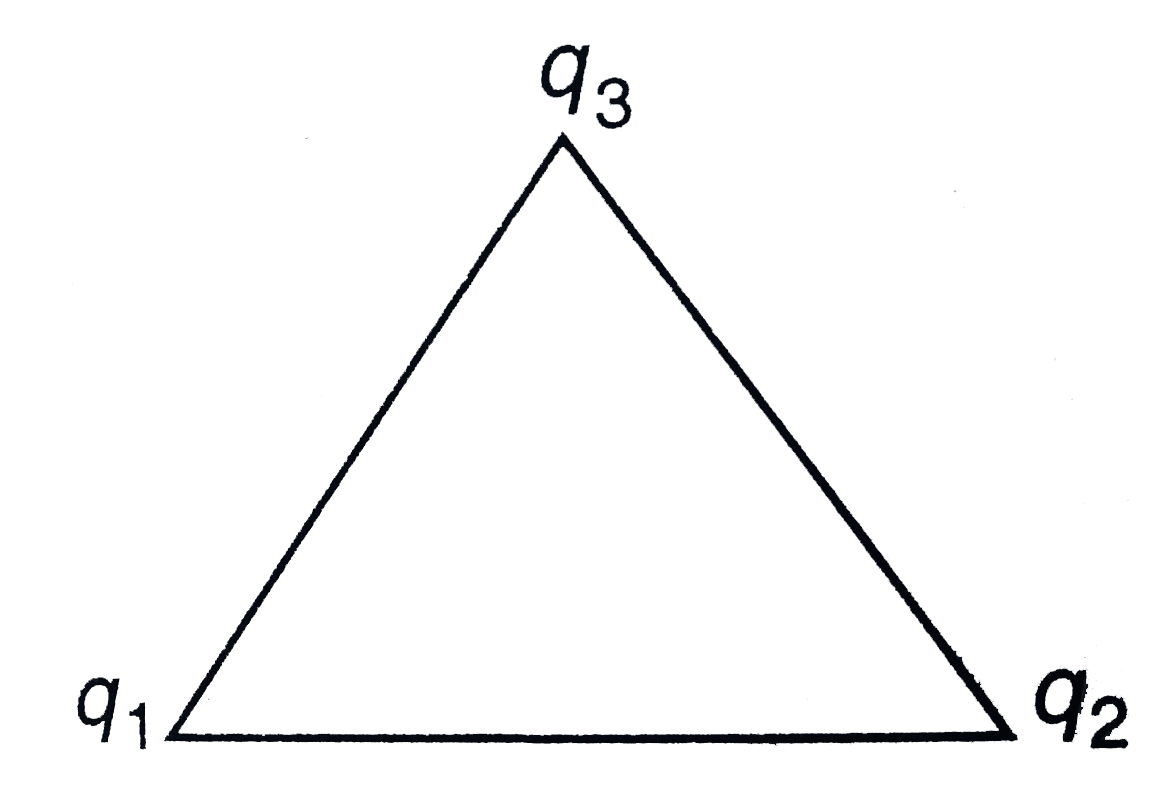Consider three charges q1,q2 and q3 each equal to q, at the vertices of an equilateral triangle of side l. What is the force on a charge Q placed at the centroid of the triangle?
3Qq4πε0l2
2Qq4πε0l2
Qq2πε0l2
zero
The correct Answer is:D
To solve the problem of finding the force on a charge Q placed at the centroid of an equilateral triangle with charges q1,q2,q3 each equal to q at the vertices, we can follow these steps:
1. Identify the Geometry and Symmetry:
- The charges q1,q2,q3 are at the vertices of an equilateral triangle with side length l.
- The centroid of an equilateral triangle is equidistant from all three vertices.
2. Calculate the Distance from Centroid to a Vertex:
- The distance from the centroid to any vertex of an equilateral triangle is given by:
r=l√3
3. Determine the Force due to One Charge:
- The force F on charge Q due to one charge q at a distance r is given by Coulomb's law:
F=kqQr2
- Substituting r=l√3:
F=kqQ(l√3)2=kqQl23=3kqQl2
4. Resolve the Forces into Components:
- Due to symmetry, the forces exerted by the three charges on Q will have components that cancel out.
- Each force F can be resolved into horizontal and vertical components.
- Since the triangle is equilateral, the angle between any two forces is 120∘.
5. Calculate the Net Force:
- The horizontal components of the forces due to q1,q2,q3 will cancel each other out.
- Similarly, the vertical components will also cancel out due to symmetry.
- Therefore, the net force →Fnet on Q is zero.
Final Result:
→Fnet=0
- The charges q1,q2,q3 are at the vertices of an equilateral triangle with side length l.
- The centroid of an equilateral triangle is equidistant from all three vertices.
- The distance from the centroid to any vertex of an equilateral triangle is given by:
r=l√3
- The force F on charge Q due to one charge q at a distance r is given by Coulomb's law:
F=kqQr2
- Substituting r=l√3:
F=kqQ(l√3)2=kqQl23=3kqQl2
- Due to symmetry, the forces exerted by the three charges on Q will have components that cancel out.
- Each force F can be resolved into horizontal and vertical components.
- Since the triangle is equilateral, the angle between any two forces is 120∘.
- The horizontal components of the forces due to q1,q2,q3 will cancel each other out.
- Similarly, the vertical components will also cancel out due to symmetry.
- Therefore, the net force →Fnet on Q is zero.
→Fnet=0
Topper's Solved these Questions
- BOOK - NCERT FINGERTPS ENGLISHCHAPTER - ELECTRIC CHARGES AND FIELDSEXERCISE - ASSERTION & REASON15videos
ELECTRIC CHARGES AND FIELDS
- BOOK - NCERT FINGERTPS ENGLISHCHAPTER - ELECTRIC CHARGES AND FIELDSEXERCISE - Electric Charges5videos
ELECTRIC CHARGES AND FIELDS
- BOOK - NCERT FINGERTPS ENGLISHCHAPTER - DUAL NATURE OF RADIATION AND MATTER EXERCISE - Assertion And Reason15videos
DUAL NATURE OF RADIATION AND MATTER
- BOOK - NCERT FINGERTPS ENGLISHCHAPTER - ELECTROMAGNETIC INDUCTIONEXERCISE - NCERT Exemplar6videos
ELECTROMAGNETIC INDUCTION
Similar Questions
Consider three charges q1,q2 and q3 each equal to q at the vertices of an equilateral triangle of side 'l' what is the force on any charge due to remaining charges.
View SolutionThree charges of equal magnitude q is placed at the vertices of an equilateral triangle of side l. The force on a charge Q placed at the centroid of the triangle is
View Solution
Knowledge Check
- Question 1 - Select One
Consider the charges q,q and -q placed at the vertices of an equilateral triangle of each side l. What is the force on each charge ?
Aq24√2πε0l2B−q24πε0l2Cq24πε0l2Dzero
Three charges +q, -q and +q are kept at the corners of an equilateral triangle of side d. Find the resultant electric force on a charge +q placed at the centroid O of the triangle.
View SolutionThree charges 2q,−q,and−q are located at the vertices of an equilateral triangle. At the center of the triangle,
View SolutionThree charges q1=1μC,q2=2μC and q3=3μC are placed on the vertices of an equilateral triangle of side 1.0 m. Find the net electric force acting on charge q1
 View Solution
View SolutionThree point charges q are placed at three vertices of an equilateral triangle of side a. Find magnitude of electric force on any charge due to the other two.
View SolutionThree charges Q,(+q) and (+q) are placed at the vertices of an equilateral triangle of side l as shown in the figure. It the net electrostatic energy of the system is zero, then Q is equal to
 View Solution
View SolutionThree charges Q,(+q) and (+q) are placed at the vertices of an equilateral triangle of side l as shown in the figure. It the net electrostatic energy of the system is zero, then Q is equal to
 View Solution
View SolutionConsider three charges q,−q, (in Sl units) at the vetrices of an equilateral triangle with side length b. The magnitude of electric field at the centroid of the triangle is :
View Solution

